Marketing can (and should) be a part of pipeline acceleration and progression, especially if you’re going after enterprise prospects.
Those deals don’t close in 30 days. It’s a long process involving multiple stakeholders, executive approvals, and several rounds of risk assessments and negotiations.
That’s what your sales reps are up against.
And that’s why Marketing needs to support Sales and provide air cover throughout the entire deal cycle, not just at the beginning.
Here’s our playbook for pipeline acceleration.
Marketing needs full-funnel influence
Often, Marketing provides support with sales engagement content, but salespeople are the only distribution channel for it.
Marketing has no control over whether that content is actually reaching people within open opportunities, and they’ve got no way of measuring whether the content that is reaching decision-makers is having any kind of impact on the deal.
At best, Marketing is able to run some supporting ads with something like Demandbase or 6sense, but only at the account level.
So, they still don’t know if that content is connecting with actual buying group members.
Instead, Marketing needs to be able to support the entire sales cycle. They need a distribution channel for their content that Marketing owns and a way to measure their influence on revenue.
How contact-level ads help accelerate pipeline
Contact-level advertising allows you to show ads to specific people in your target accounts.
This means Marketing can deliver personalized air cover that aligns with the sales rep’s goal, be that convincing a reluctant decision-maker or generating intent signals to better personalize their outreach.
Here’s how contact-level ads help you accelerate pipeline.
Multi-threading open opportunities
We know that in enterprise sales, we’re not just selling to one person.
There is an entire buying committee involved (usually with around 13 people on it), and each of them has their own goals and objections.
Salespeople know this, but they’re unlikely to be able to meet with everyone on the buying committee. But Marketing can provide additional coverage with ads that address the "behind-the-scenes" influencers of a deal.
Say one of your reps has an intro call for your demand gen tool with the Content Marketing Manager at a target account. They schedule a demo, and the account eventually becomes an open opportunity.
The rep asks who else they should invite to the demo, and the Content Marketing Manager recommends they invite the Head of Marketing, ABM Manager, and Marketing Operations Lead.
For whatever reason, the Head of Marketing and the ABM Manager don’t attend. They’re still part of the buying group, though, and the purchase won’t get approved without their sign-off.
Marketing can support Sales here by targeting those specific stakeholders with contact-level ads that showcase your product’s value, while the salesperson is actively pursuing the Content Marketing Manager and trying to schedule a follow-up.
Influence reluctant decision-makers
Contact-level ads help Revenue teams solve another huge problem that stalls pipeline: buyers who don’t want to talk to salespeople.
One study found that as many as 75% of B2B buyers would prefer a rep-free sales experience.
Contact-level ads help you influence those buying group members in a way that better aligns with their buying preferences.
For example, you can use ads to promote quick pre-recorded product demos to stakeholders who decline to attend a live demo.
Help sales know when to follow-up
Contact-level ads can create powerful intent signals that help Sales prioritize their outreach, personalize their messaging, and understand when to re-engage with deals that might have stalled.
Marketing continues to show ads during the pipeline progression phase, and Sales gets notified when a prospect clicks them. Then the rep can send more relevant follow-up emails based on what each prospect engaged with.
In some instances, a deal might go stale for a month or two, but the opportunity is still open.
If Marketing is still running ads and the prospect clicks, this is an entry point for sales to follow up with them at that moment, helping them capitalize on immediate interest.
Deliver personalized touchpoints
By aligning Marketing and Sales on who to target and what message to deliver, and by using custom ad journeys (a series of ads that adapts to how prospects engage with them), you can remove friction, improve Marketing’s ability to measure its influence on revenue and provide truly personalized touchpoints.
In the B2B world, that’s critical, where buyers have even higher expectations (than B2C buyers) for personalization.
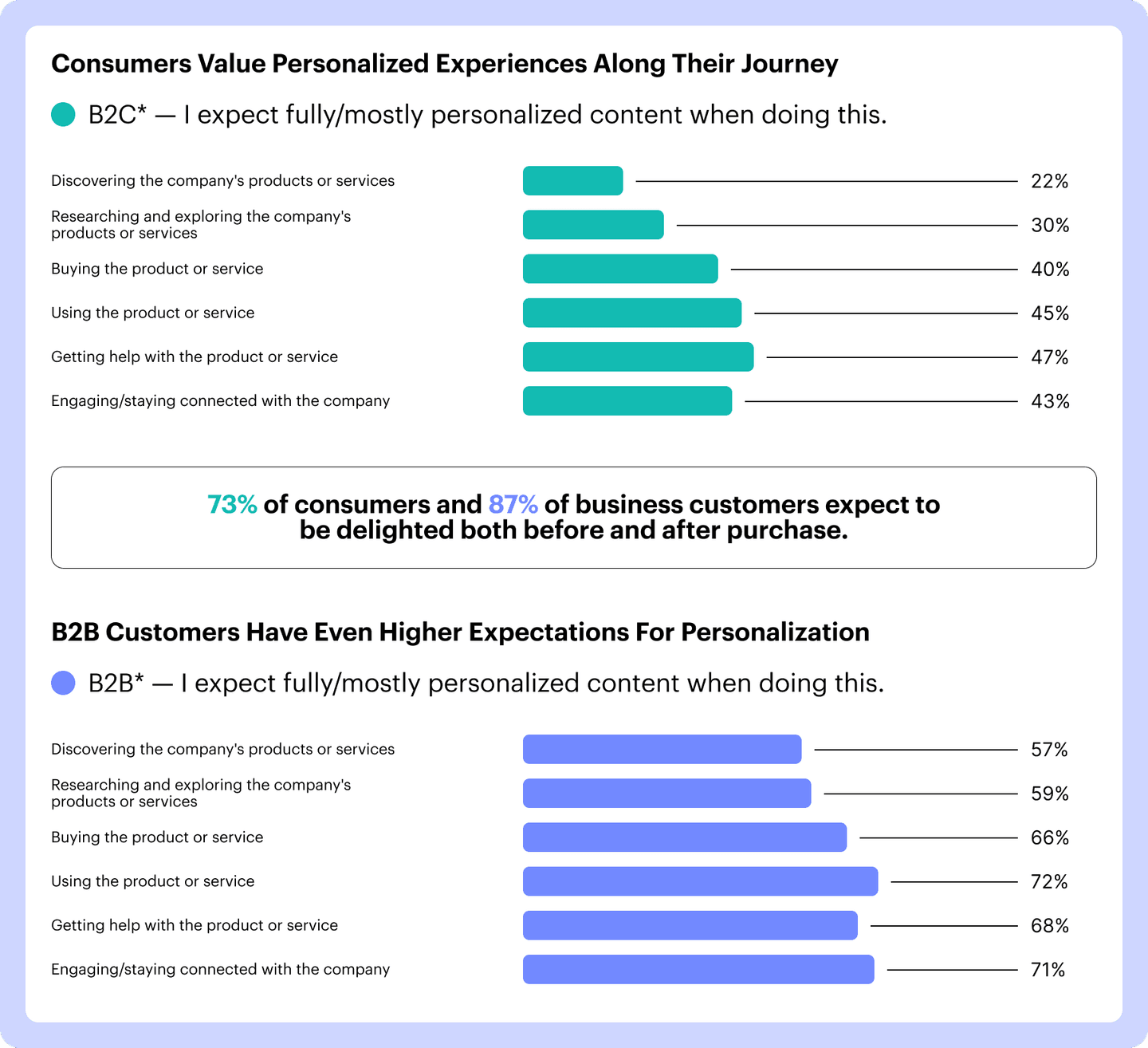
Contact-level ads help Marketing deliver messaging that’s relevant to where the prospect is in the sales cycle and to the specific pain points and objections that stakeholder has.
If you’re selling MarTech, the VP of Marketing might care about how your tool can help them reach more prospective buyers or improve their ability to measure influence.
The CTO doesn’t care about any of that. They care that your software is compliant, secure, and can integrate effectively with the existing tech stack without requiring a full overhaul.
With contact-level ads, you can hit each buying group member with personalized ads that tie directly to the objections they’ve raised during the sales process.
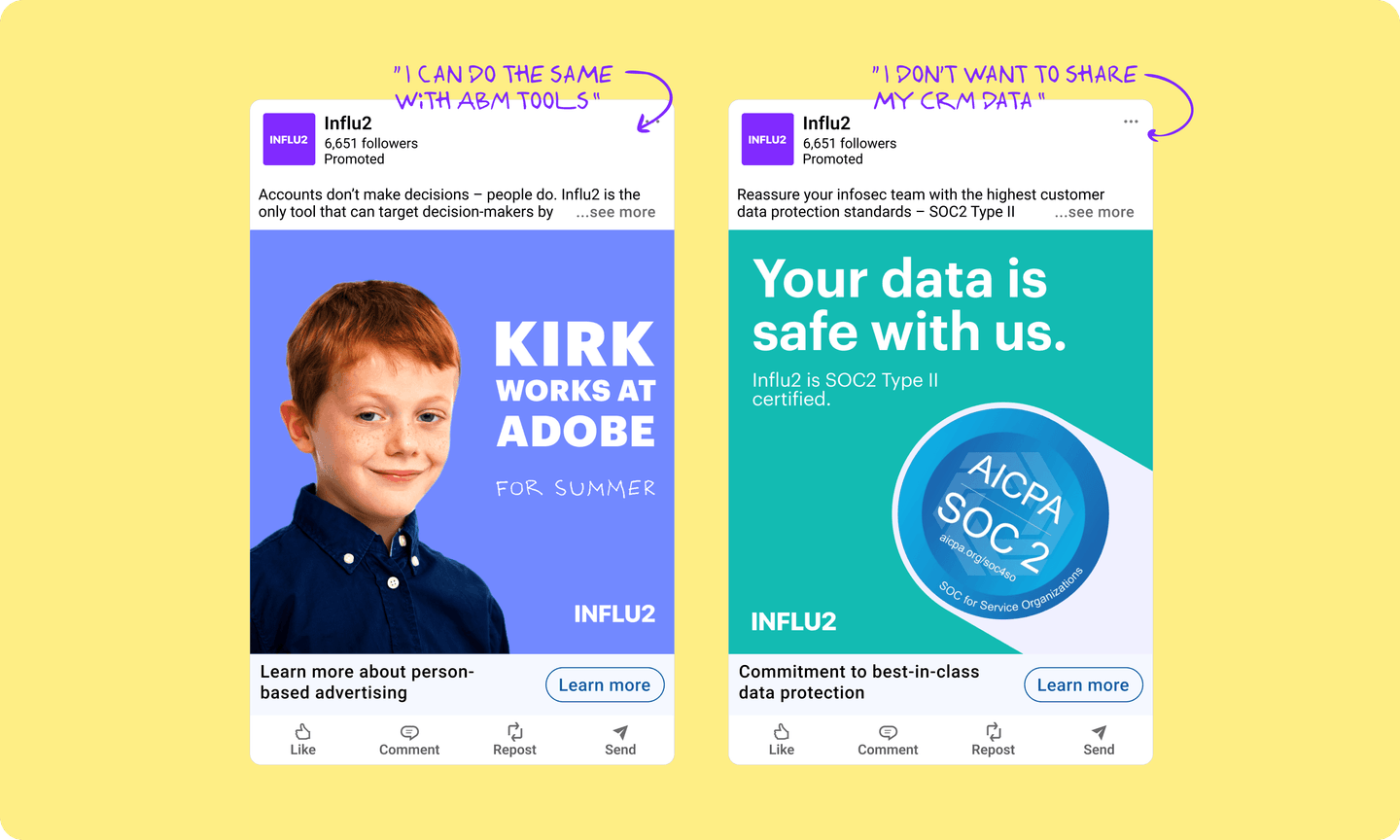
For us, pipeline acceleration is about more than just speeding things up—it’s about ensuring every interaction adds value, builds trust, and aligns with what each decision-maker needs to take the next step.
Let’s get into how.
How to accelerate pipeline with contact-level ads
This playbook is based around persona-specific ad journeys that align with the account’s stage in the sales pipeline.
It’s not about replacing the traditional sales motion—ads won’t do that.
Nor is it just about being omnipresent, although that is important—the Marketing Rule of Seven states that, on average, a prospect needs to see your brand’s message seven times more before they buy.
It's about supporting the AE at each stage of the pipeline, whether that’s getting the prospect to show up to a meeting or influencing a stubborn stakeholder toward the end of the deal cycle.
By using contact-level ads to get your message in front of specific contacts, you’re not restricted to generic account-level messaging. Your ads can address prospect-specific pain points and create a cohesive journey as prospects move through the sales cycle.
1. Align the ad journey with pipeline stages
Before you start designing ad creative, you need to map out the buyer journey.
We use the same pipeline stages as our AEs, and divide them into three ad stages:
- Scheduled: Our goal is to get the prospect to attend the meeting with their AE.
- Investigate and qualify: Our goal is to support the AE’s demo and pitch.
- Validate, proposal, and procurement: Our goal is to help the AE share implementation resources, social proof, use case content, and objection-handling messaging.
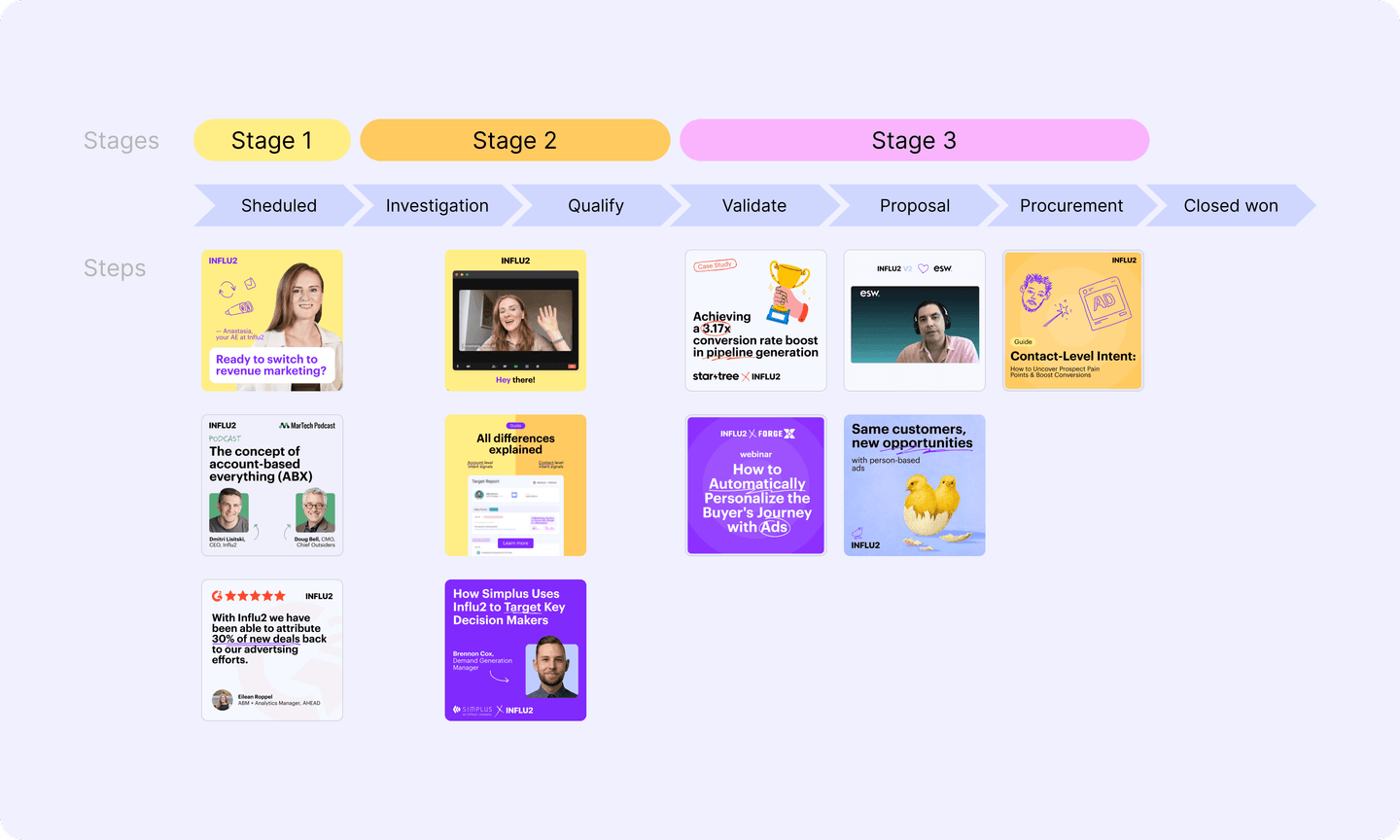
Each stage will use different ad content and messaging to influence the goal we have for that specific stage. For example, the first stage is all about getting the prospect to attend the meeting, while the last stage focuses more on case studies, social proof, and real-life use cases.
The ad content needs to be personalized to each persona, which means we need to have a different ad journey for every persona within an account.
Sync accounts to persona-specific cohorts
To build ad journeys for each cohort, we need to set up criteria for syncing audiences from your CRM into a Cohort.
For us, this criteria is when a prospect converts to the pipeline, and an opportunity is created in Salesforce.

Each buying group member is automatically added to their respective Cohort depending on the persona tag assigned to them in the CRM.
Design engagement-based ad journeys
There are multiple steps within each stage of the ad journey. Each step contains different ads.
All prospects move through the stages together, triggered by updates in Salesforce.
For example, when the AE completes the initial demo and moves the account forward to Investigation in Salesforce, this acts as a trigger for the ad journey to move to Stage 2 and helps keep Marketing and Sales aligned on where each prospect is in the pipeline and what they need to progress.
Individual prospects move through the steps based on time and engagement signals.
For example, when an account moves from stage 1 to stage 2, all prospects see the step 1 ad from their respective persona-based ad journey.
They’ll start seeing a new ad (i.e., move to step 2) when:
- They click on an ad, or
- They reach 20 impressions for the same ad, or
- Three weeks have passed
Stage 1: Pre-meeting ad set
The first set of ads in our pipeline acceleration playbook (triggered by opportunity creation in Salesforce) is focused on helping the AE influence meeting attendance. In other words, avoiding no-shows.
We do this with what we call High-Impact ads: creative that literally puts a face to the name and establishes a more personalized connection between the salesperson and the prospect.

Not only is this a nice personal touch, but it's also a handy psychological influencer.
A meeting on the calendar is easy to ignore, but when prospects see the name, face, and personalized message from the rep? It’s a lot tougher to just not show up.
Stage 2: Post-meeting ad set
Then, depending on whether the prospect attended the meeting or not, they see one of two ad sets.
If they don’t show up, they’ll get an ad set designed to remind them why they booked the meeting in the first place. We try to reintroduce the product's value in a concise format, such as a short product demo video, and provide them with an easy opportunity to reschedule.
Here’s an example.
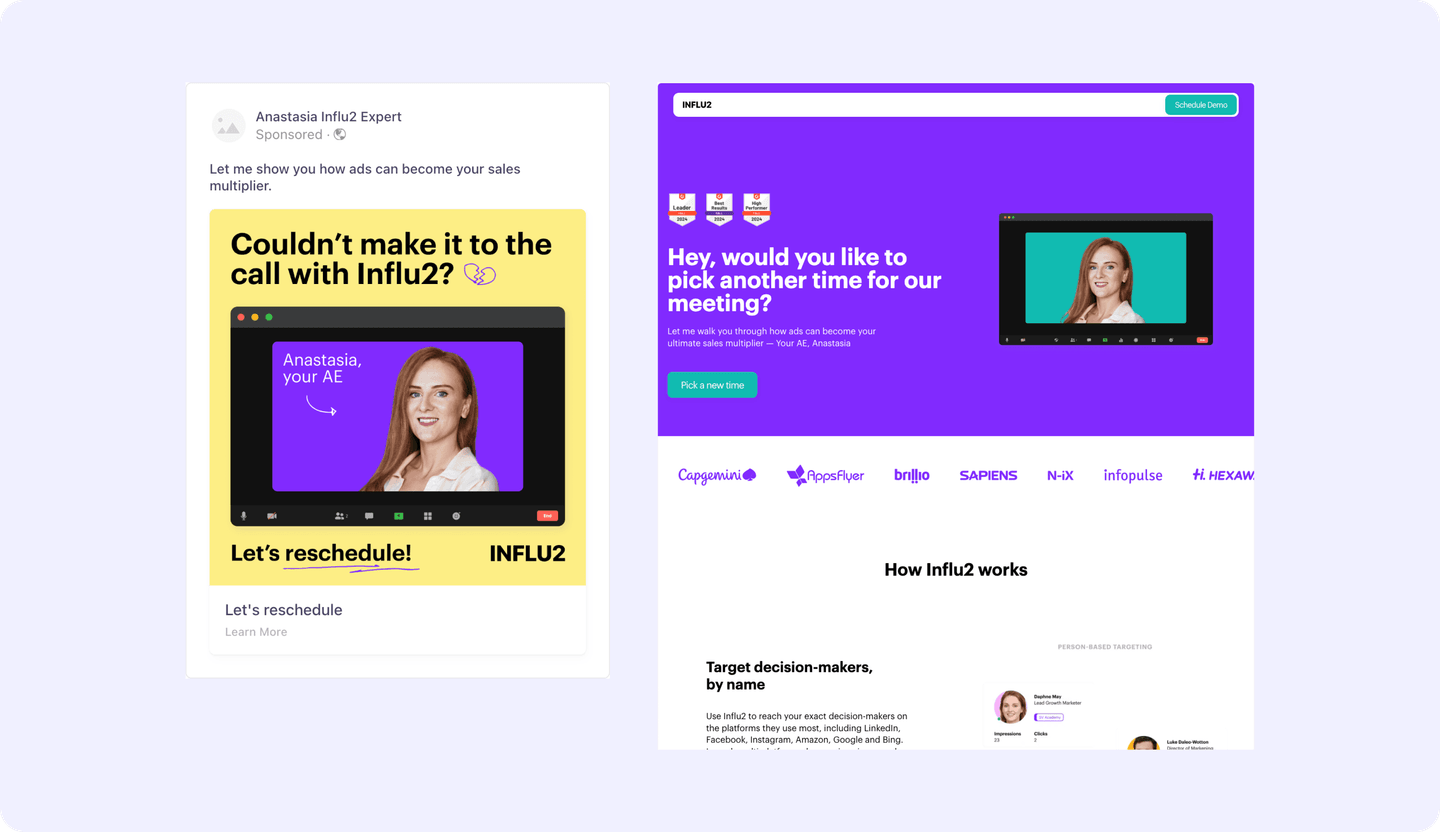
The trigger for this would be “meeting no-show” from the CRM.
If they did attend the meeting, then the AE moves them forward to the next pipeline stage, which triggers the entire account to move to stage 2 in our ad journey.
The first step in that stage is a personalized thank you message from the AE and a quick video demo that they can refer back to. Prospects within the account that weren’t part of the meeting—but are in the buying group—see a different message.
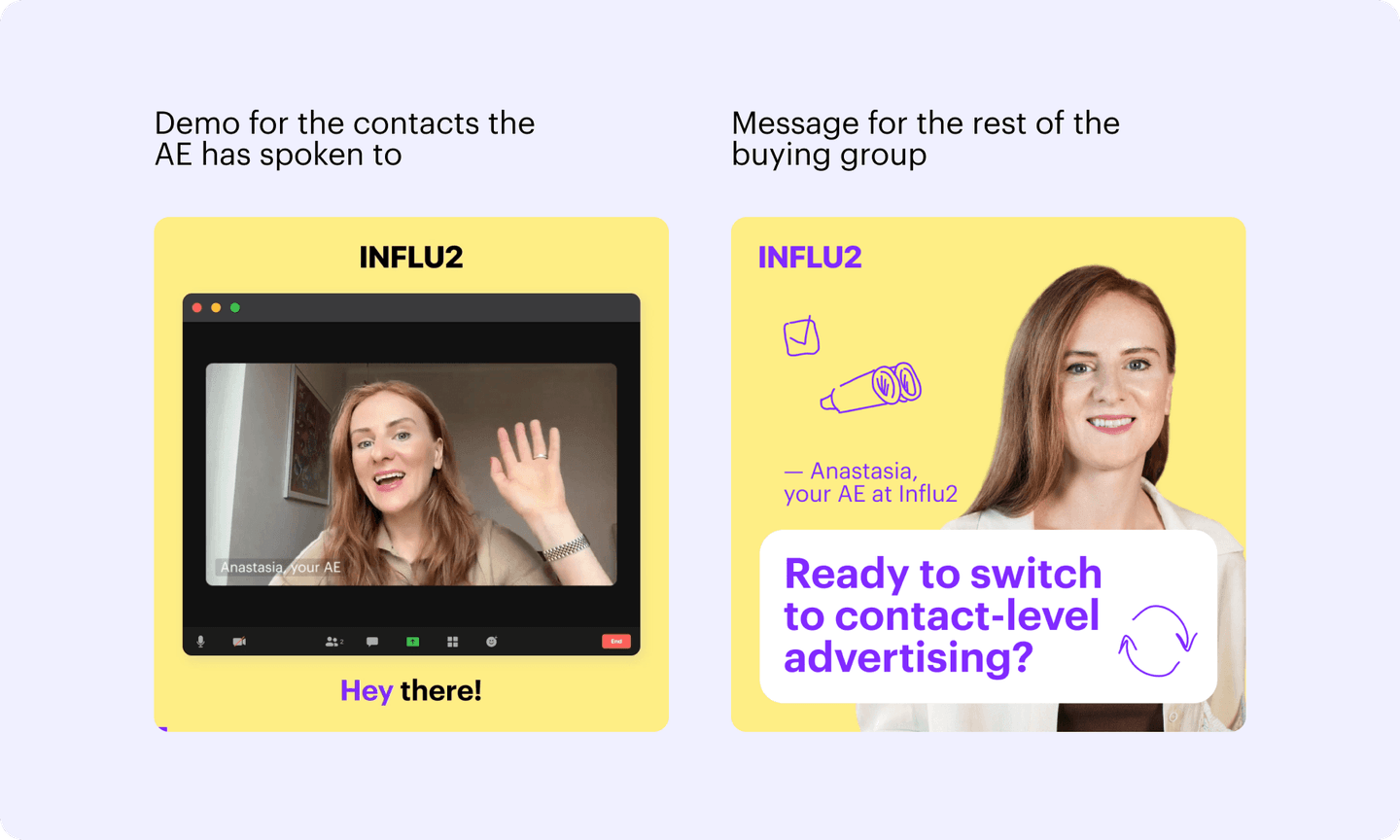
Stage 3: Deal closure ad set
The third stage in the ad journey utilizes a variety of content types to influence deal closure, including:
- Product feature explainers, guides, and playbooks to demonstrate how to get value out of your product
- Case studies and ROI-focused content tailored to the prospect’s specific pain points
- Webinars that show how existing customers put your product into practice
- Reviews, testimonials, and thought leadership to leverage social proof and develop trust and authority

Focus on the metrics that matter
The primary metric that matters for pipeline acceleration is revenue.
This is a little tricky, though.
Many marketers are concerned about using this as their success metric since they feel like their efforts are so disconnected from revenue, especially if they don’t have influence throughout the sales funnel.
Marketers measure what they can, and oftentimes, that's what prevents them from tracking the full influence their campaigns have on revenue outside of direct attribution.
They end up tracking things like MQLs tied to form fills, which isn’t exactly the best measurement of marketing influence (read why here).
With Influ2, you know exactly who your ads reach even without form fills So you can connect their engagement to influenced revenue even after an opportunity is created.
For instance, say Sales cold-called a lead and was able to schedule a demo without that person interacting with Marketing. Once they're an open opportunity, Marketing starts showing them ads to provide air coverage for the deal, and they click.
With Influ2, Marketing can track that influence even though the prospect never filled out a form and didn't engage with Marketing until after they were already added to the pipeline.
Final thoughts
Many B2B brands still treat pipeline acceleration as purely a sales function, relying on SDRs and AEs to handle most of the heavy lifting.
Most marketers want more influence over the sales pipeline, but they’re limited by account-based tools that hyperfocus on generating demand and leads.
Contact-level advertising is critical to supporting every part of the sales cycle, not just the beginning.
Of course, once you’ve closed the account, you’ll want to make sure you keep them.








